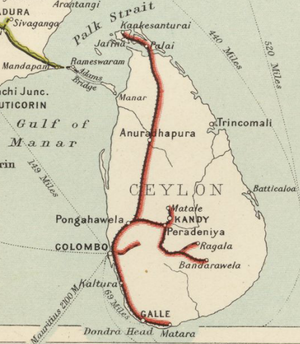Ceylon Government Railway
The Ceylon Railway Company was formed as a joint stock company in 1847 to establish and operate a railway line from Colombo to Kandy in the British colony of Ceylon (today the state of Sri Lanka), principally to facilitate the local planters. Construction commenced in 1856 but, after not a great deal of progress, concerns were voiced as to the economic viability of the enterprise (whether the 5% guaranteed return was disproportionate to the escalating cost of construction). The Secretary of State for the Colonies- subsequently annulled the contract and took over all the company’s assets and liabilities and the Company was dissolved in 1862. Once the government had taken over the company’s assets it set about fulfilling construction of a railway system for the island by inviting tenders from interested building contractors and taking over three existing contracts, one with Robert Stephenson & Co., locomotive engineers. [1]

The Ceylon Government Railway(CGR) was established by the British Colonial Government in 1864. The main reason for building a railway system in Ceylon was to transport tea and coffee from the hill country to Colombo. The railway was totally independent of the Indian Railway system [2]. Initially the service began with the mainline of 54 kilometres connecting Colombo and Ambepussa [3].
The 'Colombo Port' was established in 1875 and connected to the CGR mainline see separate page for information
Extensions were made to the main line in 1867, 1874, 1885, 1894 and 1924, extending its service to Kandy, Nawalapitiya, Nanu Oya,Bandarawela and Badulla, respectively. Many other railway lines were added to Ceylon Railway System within the first century of its life, such as a line to Matale in 1880, Coast Railway Line in 1895, Northern Line in 1905, Mannar Line in 1914, Kelani Valley in 1919, Puttalam Line in 1926, and railway line to Batticaloa and Trincomalee in 1928 [3].
Records
An on-line search of the India Office Records (IOR) records held at the British Library relating to this railway [4] gives the following entry: -
- L/F/7/2176; "Collection 370/21: Railways: Miscellaneous: Indo-Ceylon Railway connections, disputes between the Ceylon Government and the South Indian Railway relating to traffic."; 1915-1926
References
- ↑ H.M. Government “Statute Law Repeals: Nineteenth Report : Draft Statute Law (Repeals) Bill; April 2012"; pages 121-122, paragraphs 3.29-3.31;. Retrieved on 2 January 2016
- ↑ Sri Lanka Government "Railways/History";. Retrieved on 2 January 2016
- ↑ 3.0 3.1 Wikipedia "Sri Lanka Railways"; Retrieved 13 Dec 2017
- ↑ “British Library Archives and Manuscripts Catalogue” - Search; Retrieved 3 Apr 2016